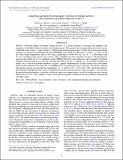Substellar objects in nearby young clusters (SONYC). VIII. Substellar population in Lupus 3
Abstract
SONYC - Substellar Objects in Nearby Young Clusters - is a survey program to investigate the frequency and properties of substellar objects in nearby star-forming regions. We present a new imaging and spectroscopic survey conducted in the young (∼1 Myr), nearby (∼200 pc) star-forming region Lupus 3. Deep optical and near-infrared images were obtained with MOSAIC-II and NEWFIRM at the CTIO 4 m telescope, covering ∼1.4 deg2 on the sky. The i-band completeness limit of 20.3 mag is equivalent to 0.009-0.02 M☉, for AV ≤ 5. Photometry and 11-12 yr baseline proper motions were used to select candidate low-mass members of Lupus 3. We performed a spectroscopic follow-up of 123 candidates, using VIMOS at the Very Large Telescope, and we identify 7 probable members, among which 4 have spectral type later than M6.0 and Teff ≤ 3000 K, i.e., are probably substellar in nature. Two of the new probable members of Lupus 3 appear underluminous for their spectral class and exhibit emission line spectrum with strong Hα or forbidden lines associated with active accretion. We derive a relation between the spectral type and effective temperature: Teff = (4120 ± 175)-(172 ± 26) × SpT, where SpT refers to the M spectral subtype between 1 and 9. Combining our results with the previous works on Lupus 3, we show that the spectral type distribution is consistent with that in other star-forming regions, as well as the derived star-to-brown dwarf ratio of 2.0-3.3. We compile a census of all spectroscopically confirmed low-mass members with spectral type M0 or later.
Citation
Mužić , K , Scholz , A , Geers , V C , Jayawardhana , R & Martí , B L 2014 , ' Substellar objects in nearby young clusters (SONYC). VIII. Substellar population in Lupus 3 ' , Astrophysical Journal , vol. 785 , no. 2 , 159 . https://doi.org/10.1088/0004-637X/785/2/159
Publication
Astrophysical Journal
Status
Peer reviewed
ISSN
0004-637XType
Journal article
Description
This work was co-funded under the Marie Curie Actions of the European Commission (FP7KCOFUND). A.S. acknowledges financial support through the grant 10/RFP/AST2780 from the Science Foundation Ireland. B.L.M. was supported by the Spanish Plan Nacional de Astronomía y Astrofísica through project AYA 2011-30147-C03-03. Support for this work also came from grants to R.J. from the Natural Sciences and Engineering Research Council of Canada.Collections
Items in the St Andrews Research Repository are protected by copyright, with all rights reserved, unless otherwise indicated.

